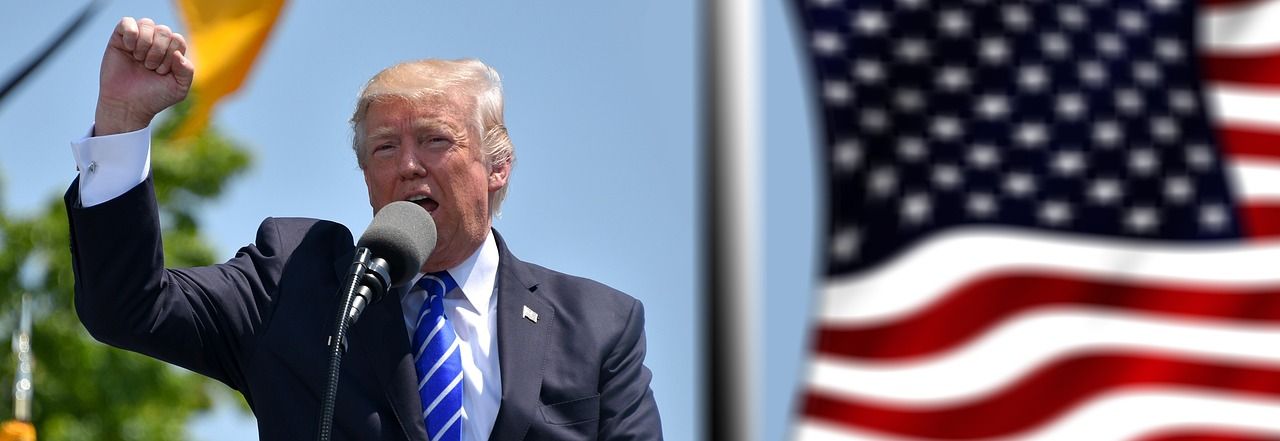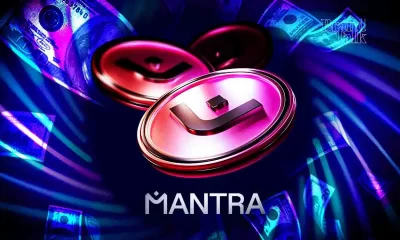Fed
Slow-Moving Fed Should Cut Rates as There is ‘No Inflation’, Trump Says
Published
7 days agoon
By
admin

President Donald Trump reiterated calls for Fed rate cuts, saying there is no inflation.
“Oil prices are down, interest rates are down (the slow moving Fed should cut rates!), food prices are down, there is NO INFLATION, and the long time abused USA is bringing in Billions of Dollars a week from the abusing countries on Tariffs that are already in place,” Trump said on a Truth Social post on Monday.
Trump imposed tariffs on several nations last week, boosting the total levy on China to 54%, which drew retaliatory action. Since then, markets have collapsed, with futures tied to Wall Street’s tech-heavy Nasdaq index hitting the lowest since January 2024. Bitcoin fell to under $75,000 early Monday.
The risk-off, coupled with OPEC’s plan to boost production, has driven the West Texas Intermediate (WTI) crude oil per barrel price lower by 16% to $60 in four trading days. A lower crude is known to inject disinflation into the global economy.
Trump’s bias for Fed rate cuts is consistent with the market pricing for five Fed rate cuts this year. Potential Fed easing may help markets better absorb the impact of Trump’s aggressive tariffs policy, which will likely stay here for some time.
Trump noted in his early Monday Truth Social post that China has made enough for decades while taking advantage of the U.S.
“The biggest abuser of them all, China, whose markets are crashing, just raised its Tariffs by 34%, on top of its long term ridiculously high Tariffs (Plus!), not acknowledging my warning for abusing countries not to retaliate. They’ve made enough, for decades, taking advantage of the Good OL’ USA! Our past “leaders” are to blame for allowing this, and so much else, to happen to our Country. MAKE AMERICA GREAT AGAIN!,” Trump said.
Over the weekend Trump said he won’t make a deal with China unless the trade deficit issue is solved.
Source link
You may like


Mantra Team Responds As The OM Token Price Crashes Over 80% In 24 Hours


This Week in Crypto Games: Gaming Tokens Crash Out, Eve Frontier Opens Up


Commerce Secretary Lutnick walks back tariff relief on electronics


Gold ETF Inflows Hit Three-Year High as PAXG, XAUT Outperform Wider Crypto Market


Israel’s New Study Shows 51% Of Public Is Interested In Adopting CBDC (Digital Shekel) – Is That So?


Solana Price Eyes Breakout Toward $143 As Inverse Head & Shoulders Pattern Takes Shape On 4-hour Chart
Bitcoin
Top 6 Important Fed Decisions To Know After SEC Drops Ripple Lawsuit Appeal
Published
3 weeks agoon
March 21, 2025By
adminReason to trust

Strict editorial policy that focuses on accuracy, relevance, and impartiality
Created by industry experts and meticulously reviewed
The highest standards in reporting and publishing
Strict editorial policy that focuses on accuracy, relevance, and impartiality
Morbi pretium leo et nisl aliquam mollis. Quisque arcu lorem, ultricies quis pellentesque nec, ullamcorper eu odio.
The crypto industry received a significant legal victory as Ripple CEO Brad Garlinghouse announced on March 19 that the U.S. Securities and Exchange Commission (SEC) had officially dropped its appeal against the company. The announcement came in a video posted on social media platform X, where Garlinghouse noted the regulatory agency’s decision to end its pursuit of further litigation.
Besides this interesting development, another major financial development has taken center stage in the crypto market in the past 24 hours; the outcome of the Federal Reserve’s latest meeting.
Fed Keeps Interest Rates Steady Amid Uncertainty
The outcome of the latest Fed meeting can be divided into six key decisions. First, the Federal Reserve opted to maintain interest rates at their current level, keeping the borrowing rate in a range between 4.25% and 4.5% for the second consecutive meeting. This decision is part of a continued pause in the Fed’s tightening cycle.
Related Reading
Secondly, the Fed noted that uncertainty surrounding the economy has increased, and third, the Fed’s updated projections were the shift in expectations for rate cuts in 2025. The median forecast suggests 50 basis points of cuts for the year, but a growing number of Fed officials are less convinced that rate reductions will be necessary. In December, only one official anticipated no rate cuts in 2025. However, there’s now a more divided outlook, and that number has now risen to four, as noted in a post on social media platform X by analysts at The Kobeissi Letter.
Beyond interest rates, the Fed revised its economic growth projections downward for 2025, suggesting that policymakers see slower expansion ahead. This adjustment comes alongside an increase in the Fed’s inflation forecast for the same period, reflecting concerns about price pressures persisting longer than previously anticipated. With inflation remaining a key focus, the central bank is treading carefully as it evaluates the right time to pivot toward a looser monetary stance.
Fourthly, the Fed announced that it would slow the pace of its balance sheet runoff beginning in April. This is alongside a sharp reduction in the Fed’s 2025 growth projections and a markup in their 2025 inflation forecast.
Implications For Crypto Markets And Digital Assets
For the crypto industry, the Fed’s decision to hold rates steady and its mixed messaging on future cuts introduce a dynamic situation to Bitcoin and others. The fact that the Fed is still concerned about inflation and economic uncertainty shows that the path to more accommodative policies regarding the crypto industry may not be as smooth.
Related Reading
However, if the Fed stays hesitant to cut rates and economic growth slows as projected, digital assets may face headwinds later in the year, which may slow down the predicted growth by crypto analysts.
Featured image from Unsplash, chart from Tradingview.com
Source link



On a recent episode of the Galaxy Brains podcast, Michael Saylor made the case that bitcoin isn’t a currency and that it’s best to think of it as capital and capital only.
He also shared that Tether (USDT) and Circle’s USD Coin (USDC) are the real digital currencies and unveiled his “evil genius strategy” (his own words) to get the world to adopt the U.S. dollar stablecoins as opposed to bitcoin.
In this Take, I’ll cite some of Saylor’s own words from the podcast before breaking down why many of the points he made are off base.
Capital, Not Currency
“It’s not a currency, it’s capital,” said Saylor about halfway through the episode.
“You just have to come to grips with it — it is not digital currency. It is not cryptocurrency. It is digital capital. It is crypto capital,” he added.
I searched the Bitcoin Whitepaper to see how many times the word “capital” showed up.
It isn’t mentioned once.
However, in both the title and abstract of the text, bitcoin is referred to as “electronic cash.” While cash can of course also be capital, it’s not only capital. To think of bitcoin only as capital is to deny certain of its most essential properties — like the ability to use it to transact with anyone anywhere in the world permissionlessly.
To deny bitcoin as a currency is to deny a large part of its value proposition. Bitcoin’s roles as a Store of Value (SoV) and a Medium of Exchange (MoE) are inextricably linked. For more on this, I’d advise you (and Michael Saylor) to read Breez CEO Roy Sheinfeld’s piece “Bitcoin’s False Dichotomy between SoV and MoE”.
As the episode proceeded Saylor continued to (poorly) make the case for why bitcoin is capital and not currency.
“There are a lot of maxis who are like ‘No, we want it to be a currency. We want to be able to pay for coffee with our bitcoin. Pay me in bitcoin,’” he said. “It’s like ‘Pay me in gold. Pay me in a building. Pay me with a slice of your professional sports team. Pay me with a Picasso.’”
It’s actually not like that at all.
Sure, bitcoin is scarce, somewhat like gold, Manhattan real estate, sports teams or famous paintings, but it has a number of other properties that make it far different from any of these other assets.
To illustrate a dimension of that point, I’ll cite my colleague Alex Bergeron:
I invite anyone who thinks Bitcoin is like gold to launch a custodial gold wallet.
I’ll wait.
— Alex B (@bergealex4) December 22, 2024
And then Saylor cited — wait for it — Fed Chair Jerome Powell’s take on bitcoin in efforts to drive home his point that bitcoin is capital, not currency.
“The reason bitcoin rallied past $100,000 is because Jerome Powell on stage said to the world, bitcoin does not compete with the dollar, it competes with gold,” he said.
Oddly enough, Saylor said this without acknowledging that the man who said this is the head of the institution that Bitcoin should theoretically replace.
USDT, Not BTC
In the interview, Saylor also drove home the point that the real digital currencies are U.S. dollar stablecoins.
“The cryptocurrency, the digital currency, is Tether (USDT) and Circle (USDC),” he said. “It’s a stablecoin U.S. dollar — that’s the digital currency.”
This is when I started to get nauseous.
For those who don’t yet know this, Bitcoin came into the world in the wake of the Great Financial Crisis of 2008, when the U.S. government in conjunction with the U.S. Federal Reserve opted to print U.S. dollars en masse (debase the currency) to bail out failing banks, the burden of which was laid both on the U.S. taxpayers and U.S. dollar holders worldwide.
Bitcoin is a decentralized money that was created as an alternative to the U.S. dollar and all other fiat currencies. Trying to convince people that bitcoin is not this is disingenuous at best, deeply manipulative at worst.
But this isn’t even the worst of what Saylor had to say on the episode.
He went on to propose that the banks that got bailed out in the 2008 financial crisis issue their own stablecoins, which would help prop up the U.S. debt market.
“They ought to just create a normal regime to issue digital currency backed by U.S. treasuries,” said Saylor.
“The U.S. ought to have a framework so Tether relocates to New York City. That’s what you want, right? And then you ought to basically have a free-for-all where JP Morgan or Goldman Sachs can issue their own stablecoin,” he added.
No, Michael Saylor, that’s not what I want. In fact, it’s very far from what I want.
I don’t want Tether anywhere near New York City (my hometown) and I don’t want JP Morgan and Goldman Sachs issuing U.S. dollar stablecoins that they control, essentially the equivalent of CBDCs.
When I think about Goldman Sachs, the first thing that comes to mind is award-winning writer Matt Taibbi’s description of the institution from his New York Times bestseller Griftopia.
“The first thing you need to know about Goldman Sachs is that it’s everywhere,” began Taibbi in the book. “The world’s most powerful investment bank is a great vampire squid wrapped around the face of humanity, relentlessly jamming its blood funnel into anything that smells like money.”
Goldman Sachs, much like the U.S. Federal Reserve, is an institution that sucks the life force from humanity. Bitcoin was designed to take power away from such institutions, not strengthen them.
Toward the end of the episode, Saylor laid out his master plan for bitcoin and U.S. dollar stablecoins.
Here it is:
“Everybody outside the U.S. would give their left arm to be capitalized on U.S. bonds. So, my strategy would be — and I really think it’s an evil genius strategy; it’s so good that our enemies would hate us, but our allies would complain, too. And the U.S. would make $100 trillion in a heartbeat.
Here’s the strategy: You dump gold, demonetize the entire gold network. You buy bitcoin — 5 million or 6 million bitcoin — and you monetize the bitcoin network. All the capital in the world, sitting in Siberian real estate or Chinese natural gas or every other currency derivative that’s held as a long-term store of value — Europeans, Africans, South Americans, Asians, they all just dump their crappy property and their crappy capital assets and they buy bitcoin. The price of bitcoin goes to the moon.
The U.S. is the big beneficiary. U.S. companies are the big beneficiary. And while you’re doing that, you normalize and support digital currency, and you just define digital currency as the U.S. dollar backed by U.S. dollar equivalents in a regulated U.S. custodian that’s audited. What happens next?
$150 billion of stablecoins goes to $1 trillion, $2 trillion, $4 trillion, $8 trillion, probably somewhere between $8 and $16 trillion, and you create $10 to $20 trillion of demand for U.S. sovereign debt.
While you’re taking away a little bit of the demand because the capital asset of bitcoin grows, you’re adding back the demand to back the stablecoin. [The digital U.S. dollar then] replaces the CNY, the Rubble. It replaces every African currency. It replaces every South American currency. It replaces the euro.
If you really believe in U.S. world reserve currency and U.S. values, every single currency in the world will actually just merge into the U.S. dollar if it was freely available.”
At this point, I stopped listening to the episode and projectile vomited all over the New York City subway car in which I was sitting.
I didn’t come into the Bitcoin space to help the U.S. run a scheme in which it acquires a large percentage of the bitcoin while hooking the world on its trash currency, and it deeply saddens me that someone that many in the Bitcoin space look up to would come up with such a conniving plan.
Bitcoin Is Money
Bitcoin is money. It’s a type of money that cannot be censored or debased that has spectacularly grown in value over the past decade, making it one of, if not the most, powerful tool ever created for individuals.
To think of it as anything less, or to try to convince people that a new iteration of an incumbent version of money is better than it, is to be deeply misinformed.
While bitcoin is capital, that’s not all it is, and please don’t let Michael Saylor or anyone else convince you otherwise.
This article is a Take. Opinions expressed are entirely the author’s and do not necessarily reflect those of BTC Inc or Bitcoin Magazine.
Source link
Bitcoin price
Don't Fall for the Bitcoin Crash – It's Just a Breather
Published
4 months agoon
December 20, 2024By
admin


If you’ve been watching bitcoin, you probably noticed the pullback yesterday. It dropped from $108,000 to $99,000 after the FOMC meeting, where the Fed cut rates, and Jerome Powell, the Fed Chair, when asked about the Strategic Bitcoin Reserve, said: “We’re not allowed to own bitcoin and not looking for a law change.”. The market, as usual, overreacted by dumping bitcoin. But let me tell you: This dip? It’s nothing to worry about.
First of all, Jerome Powell’s comments shouldn’t have surprised anyone. The Fed doesn’t control Bitcoin policy—Congress does. David Bailey, CEO of BTC Inc., even pointed this out, saying the Strategic Bitcoin Reserve would have “nothing to do with the Fed. It’d be housed at the Treasury.” So, Powell’s comments are irrelevant when it comes to a Strategic Bitcoin Reserve for the USA. The market just needed an excuse to cool off after its recent explosive run.
And honestly, dips like this are healthy—especially in a bull market. This isn’t my first rodeo. I’ve been through three bitcoin bull markets since I jumped in back in 2016, and trust me, these pullbacks are totally normal, and they’re part of the process. They shake out weak hands, consolidate support, and set the stage for even bigger moves. From my experience, we’ve only just entered this bull market, and the real fireworks aren’t coming until 2025.
Think about it: Trump hasn’t even taken office yet. His administration is likely to push pro-Bitcoin and crypto regulations, and combined with increasing institutional and global adoption the next year could be huge for the space.
So, don’t panic. Don’t let the short-term noise shake you out of the long-term game. Instead, use these pullbacks to your advantage. I’d personally be buying the dips, stacking sats, and preparing for what’s ahead.
This article is a Take. Opinions expressed are entirely the author’s and do not necessarily reflect those of BTC Inc or Bitcoin Magazine.
Source link

Mantra Team Responds As The OM Token Price Crashes Over 80% In 24 Hours

This Week in Crypto Games: Gaming Tokens Crash Out, Eve Frontier Opens Up

Commerce Secretary Lutnick walks back tariff relief on electronics

Gold ETF Inflows Hit Three-Year High as PAXG, XAUT Outperform Wider Crypto Market

Israel’s New Study Shows 51% Of Public Is Interested In Adopting CBDC (Digital Shekel) – Is That So?

Solana Price Eyes Breakout Toward $143 As Inverse Head & Shoulders Pattern Takes Shape On 4-hour Chart

Crypto malware silently steals ETH, XRP, SOL from wallets

Binance Executives Met With US Government Officials To Discuss Easing of Regulatory Supervision: Report

Michael Saylor Hints At Another MicroStrategy Bitcoin Purchase, BTC Price To Rally?

From the Crypto Trenches to the Hill: Why Solana Is Making a Big Push in Washington

Bitcoin price tags $86K as Trump tariff relief boosts breakout odds

Where Top VCs Think Crypto x AI Is Headed Next

India’s Leading Bitcoin And Crypto Exchange Unocoin Integrates Lightning

Solana Triggers Long Thesis After Pushing Above $125 – Start Of A Bigger Rally?

Popcat price surges as exchange reserves fall, profit leaders hold

Arthur Hayes, Murad’s Prediction For Meme Coins, AI & DeFi Coins For 2025

Expert Sees Bitcoin Dipping To $50K While Bullish Signs Persist

Aptos Leverages Chainlink To Enhance Scalability and Data Access

Bitcoin Could Rally to $80,000 on the Eve of US Elections

Crypto’s Big Trump Gamble Is Risky

Sonic Now ‘Golden Standard’ of Layer-2s After Scaling Transactions to 16,000+ per Second, Says Andre Cronje

Institutional Investors Go All In on Crypto as 57% Plan to Boost Allocations as Bull Run Heats Up, Sygnum Survey Reveals

Ripple-SEC Case Ends, But These 3 Rivals Could Jump 500x

Has The Bitcoin Price Already Peaked?

A16z-backed Espresso announces mainnet launch of core product

The Future of Bitcoin: Scaling, Institutional Adoption, and Strategic Reserves with Rich Rines

3 Voting Polls Show Why Ripple’s XRP Price Could Hit $10 Soon

Xmas Altcoin Rally Insights by BNM Agent I

Blockchain groups challenge new broker reporting rule

I’m Grateful for Trump’s Embrace of Bitcoin
Trending

 24/7 Cryptocurrency News5 months ago
24/7 Cryptocurrency News5 months agoArthur Hayes, Murad’s Prediction For Meme Coins, AI & DeFi Coins For 2025

 Bitcoin3 months ago
Bitcoin3 months agoExpert Sees Bitcoin Dipping To $50K While Bullish Signs Persist

 24/7 Cryptocurrency News3 months ago
24/7 Cryptocurrency News3 months agoAptos Leverages Chainlink To Enhance Scalability and Data Access

 Bitcoin5 months ago
Bitcoin5 months agoBitcoin Could Rally to $80,000 on the Eve of US Elections

 Opinion5 months ago
Opinion5 months agoCrypto’s Big Trump Gamble Is Risky

 Altcoins2 months ago
Altcoins2 months agoSonic Now ‘Golden Standard’ of Layer-2s After Scaling Transactions to 16,000+ per Second, Says Andre Cronje

 Bitcoin5 months ago
Bitcoin5 months agoInstitutional Investors Go All In on Crypto as 57% Plan to Boost Allocations as Bull Run Heats Up, Sygnum Survey Reveals

 Price analysis5 months ago
Price analysis5 months agoRipple-SEC Case Ends, But These 3 Rivals Could Jump 500x


